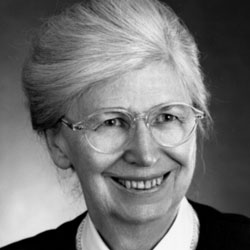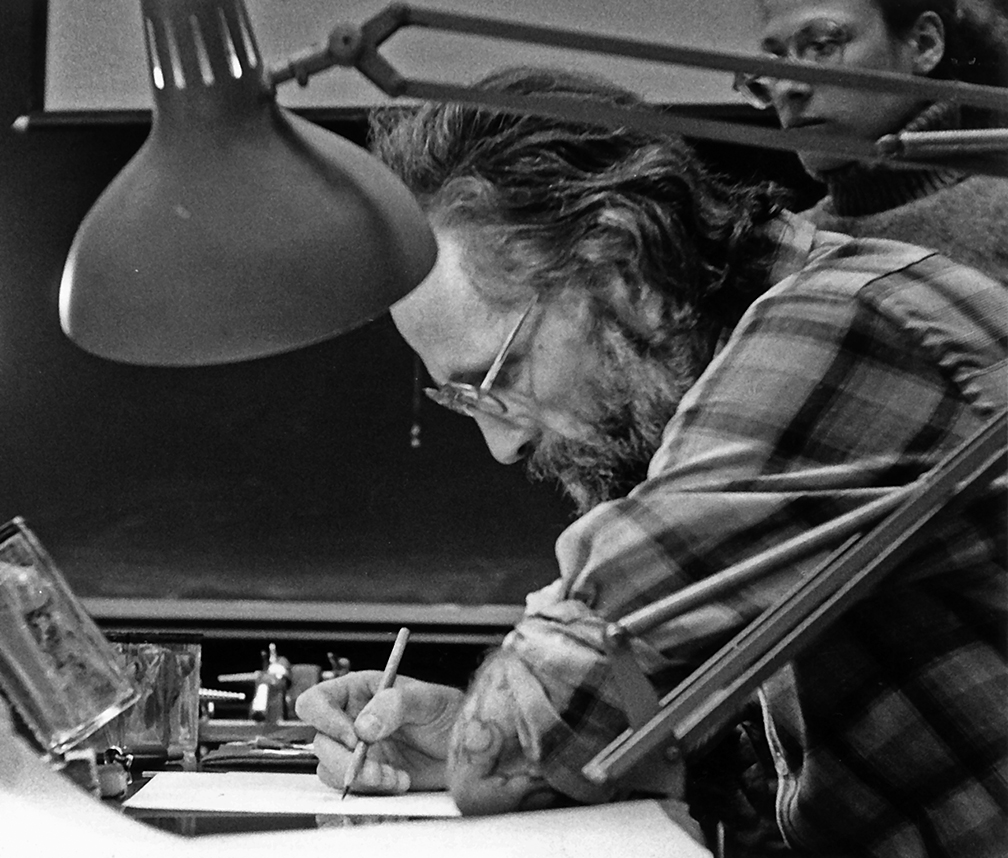Our History
Laying the Foundations: 1925 – 1945
In 1925, Maria Torrence Wishart (1893 – 1983), who had studied with Max Brödel at Johns Hopkins University, founded the Department of Medical Art Service in the Anatomy Building (now the McMurrich Building) at the University of Toronto. The Dean of the Temerty Faculty of Medicine approved her appointment as the first professionally trained medical illustrator. For the first ten years she did all the surgical and anatomical illustration work herself. From 1931 to 1939, Dorothy Foster Chubb, another former Brodel student, assisted Wishart in the service department. In 1939, she was hired by Dr. J.C.B. Grant to work on his An Atlas of Anatomy. Eila Hopper-Ross took her place as Wishart’s assistant from 1939 until 1945.
Maria Wishart
Diploma Program: 1945 – 1962
In 1945, Wishart founded a 3-year diploma course in medical illustration, at which time the name of the department changed to Art as Applied to Medicine (AAM). The department had been moved to the Banting Institute on College Street in the early 1930’s and with the establishment of an academic program, students soon needed additional studio space which was found in the old church on the corner of College and Elizabeth Streets. Students attended classes with medical students, and worked under Wishart’s supervision on illustrations of gross anatomy, pathology and surgery. As her students gained proficiency, Wishart allowed them to produce illustrations for publication under her supervision. The only instructor in the academic program at the time was Eila Hopper-Ross, who assisted Wishart part-time with teaching.
Eila Hopper-Ross
Holding Our Ground: 1962 – 1985
Nancy Grahame Joy succeeded Wishart as chair of the department in 1962. Joy had been an assistant professor in the Department of Surgery at the University of Manitoba and well known for her outstanding illustrations in Grant’s An Atlas of Anatomy and Method of Anatomy.
Nancy Grahame Joy
FROM DIPLOMA TO DEGREE: BScAAM 1962 – 1984
Joy believed that students interested in becoming medical illustrators should have a strong portfolio for admission to the program and, like Wishart, she required them to take courses with medical and dental students in the basic and clinical sciences such as anatomy, histology, physiology, and pathology. Largely as a result of Joy’s efforts, and the strong support of Dean John Hamilton, the diploma program was elevated to undergraduate status. On February 10, 1967 the Bachelor of Science program in Art as Applied to Medicine (BScAAM) became a reality. After the program reached degree-granting status, student numbers increased fourfold: in the five-year period from 1963 to 1967 there were five students; from 1968 to 1972, there were 20. With the increase in student enrolment, Joy appointed Stephen Gilbert in 1973 to teach applied art courses. Gilbert had studied with two former students of Brodel’s: Ralph Sweet, Director of the School of Medical Illustration at the University of California (1952 to 1961), and Muriel McLatchie-Miller, Director of the School of Medical Illustration at Massachusetts General Hospital (1941 to 1960).
Steve Gilbert
In Transition: 1985 – 1986
In 1985, Joy stepped down as chair of the AAM department, though she stayed on as program director for the academic year 1985 to 1986. During that period, Alex Wright, Director of the Audio-Visual Department at the Hospital for Sick Children, was appointed acting chair, part-time. Wright had taught facial reconstruction to the AAM students for over ten years, and had completed the diploma course under Wishart in 1961 and upgraded his diploma to a BScAAM in 1979.
Focusing our Strategic Position:
1986 – 1995
In 1986 Linda Wilson-Pauwels was installed as acting chair of the department. Her academic background included a diploma from the Ontario College of Art and a BScAAM. While acting chair of the program she completed a Master’s degree (MEd) and doctorate in higher education (EdD), specializing in the health profession. In 1990, Wilson-Pauwels proposed relocating the program administratively within a larger, stronger department in which new projects and joint ventures could be initiated. Dr. Bernard Langer, Chair of the Department of Surgery was quick to respond and to encourage a liaison with his department. As a result, on December 10, 1990, the AAM program officially moved out of the Basic Sciences Sector of the Temerty Faculty of Medicine and into the Clinical Sciences Sector where it became the Division of Biomedical Communications within the Department of Surgery. At that time, Wilson-Pauwels was appointed Chair of the BMC Division and Director of the newly named Bachelor of Science in Biomedical Communications program. BMC became the ninth division within the Department of Surgery at the University of Toronto.
Linda Wilson-Pauwels
From BSc to MSc: 1995
BMC faculty circa 1996. Clockwise from top left: Nicholas Woolridge, Dave Mazierski, Steve Gilbert, Margot Mackay and Linda Wilson-Pauwels (not pictured: Celia Godkin and Leila Lax).
In 1993, a BMC Graduate Advisory committee was established to prepare a proposal for a Master of Science in Biomedical Communications (MScBMC) for the School of Graduate Studies (SGS). The proposal was accepted by the University of Toronto and forwarded to the Ontario Council on Graduate Studies. In the end, the Bachelor of Science in Biomedical Communications (BScBMC) program was elevated to a Master of Science in Biomedical Communications (MScBMC) program in the fall of 1994, and the undergraduate degree was phased out.
The new graduate program relocated from 256 McCaul to the Medical Sciences Building in December of 1994. The location brought faculty and students closer to university resources such as Grant’s Museum, research labs, and the university libraries.
Two-Campus Program and Undergraduate Minor: 2004
In May 2004, an agreement went into effect between the Temerty Faculty of Medicine and the University of Toronto Mississauga (UTM) allowing BMC to become a two-campus program. Since the upgrade to a graduate program, BMC had enlarged its existing two-year student cohort from 16 to 32 (currently 34), and its faculty compliment grew to seven full-time and three part-time positions. Nine new interdisciplinary undergraduate courses were introduced on the UTM campus, with a view to creating a continuum of teaching from the undergraduate to the graduate level in biomedical, scientific and health communication. UTM students could work toward attaining a Health Science Communication (HSC) minor as an adjunct to their major degree studies.
BMC retained student and faculty studio space and offices on the St. George campus in the FitzGerald Building (150 College Street), while participating in the design of a custom, dedicated space on the UTM campus for the graduate program. Construction of the Biomedical Communications Department’s state of the art space in the Terrence Donnelly Health Sciences Complex was completed in 2011.
Administratively, the BMC Director reports to the Chair of Biology at the UTM campus and the primary appointments of BMC faculty are at UTM.
Academically, the MScBMC degree remains with the Institute of Medical Science (IMS), Temerty Faculty of Medicine at the St. George campus. Graduate appointments of BMC faculty are in the IMS.
Innovative Technology for an Innovative Program: 2008-Present
Upon Linda Wilson-Pauwel’s retirement in 2008, Nicholas Woolridge (BFA, BScBMC, MSc) assumed Directorship of Biomedical Communications. In 2011, the program moved into its new facilities at UTM, and satellite offices and classroom space in the FitzGerald Building on the St. George campus. In 2017, the downtown office and computer lab facilities moved from the FitzGerald to newly-renovated space in the Old Administration (OA) Building at 263 McCaul Street. Marc Dryer (BA, MSc, MScBMC) was appointed Associate Director of BMC in 2010, but soon after was appointed to a senior administrative position in the Department of Biology. Jodie Jenkinson (BA, MScBMC, PhD) assumed the Associate Director role, and in 2019 became the sixth Director in the program’s history.
In 2020, only nine months into Jenkinson’s appointment, the program was disrupted by the COVID-19 global pandemic. Facing unprecedented challenges, Jenkinson led the program through two successful external reviews—reaccreditation by the Commission on Accreditation of Allied Health Education Programs (CAAHEP), and the University of Toronto Quality Assurance Process (UTQAP).
In 2021, she spearheaded a year-long virtual recognition of the BMC program’s 75th anniversary, aptly themed “disruption.”
During her tenure, Jenkinson successfully secured international student bursary funds, master’s research project funding, and financial support for two Scholars-at-Risk. She contributed to the creation of the BMC Anti-Racism Committee (ARC), which comprised faculty, students, and alumni volunteers.
In 2024, Michael Corrin (BFA, BA, Hons BSc, MScBMC, CMI) became the program’s seventh director, and Shelley Wall (AOCAD, MScBMC, PhD, CMI, FAMI) assumed the role of associate director.
The UTM/BMC merger has created an innovative partnership between UTM and the Temerty Faculty of Medicine that has greatly strengthened the academic environment for the MScBMC students. This re-structuring provided new opportunities for curriculum development and reconceptualization of professional practice outcomes. The relationship expanded BMC’s network of colleagues (Anatomy, Cell Biology, Pathology, Surgery, Pharmacy, Physiology, etc.) to other disciplines including Forensic Science, Anthropology, Psychology, Biology, Palaeontology and Archaeology. Building on BMC’s successful track record of innovative research in interpretive visualization, research initiatives have strategically positioned the graduate program as one of the leaders in visual scientific communication and research in the world.
Nick Woolridge
Jodie Jenkinson
Michael Corrin
Shelley Wall
A look to the Future
Since its origins in 1945, the BMC program has evolved significantly in response to the changing nature of science, technology, communication, and our profession, and it will continue to do so. As a forward-looking program we are eager to further expand our academic and professional impact, making inroads in areas such as educational gaming, augmented reality, UI/UX design, and scientific visualization, with a constant focus on advancing discovery and understanding through the power of visual communication.










